Bloomberg Interactive TV
overview
The Bloomberg Terminal's Interactive TV media players allows you to keep up with breaking business news, even with the sound off. The player allows you to follow with live broadcasters as they discussed featured functions and shared content like charts and new stories. The interface allows you to quickly jump to past segments, access content discussed on the broadcast, or send a message directly to the show’s producer during the show.
Problem Statement
Knowing that the majority of BloombergTV viewers on the terminal often view broadcasts for extended periods of time with the sound off, can we offer a more robust option than subtitles to indicate what the anchors are currently discussing? Additionally, can we increase interaction with the Terminal by presenting links to access relevant content discussed on the broadcast?
My Role
Lead interaction designer (team of 3), responsible for interaction design, UX Research, prototyping, and build support.
Spring 2017
Publications
Why’d we build it?
The Opportunity
Interactive TV as an idea emerged after developing an understanding of the two key ways our customers consume Bloomberg TV, the passive and the active. When visiting trading floors you’ll often see TVs mounted above the desks on the floor which allows financial professionals to passively check in throughout the day or monitor news as it breaks. A sub-section of these individuals though will also place the Bloomberg media viewer on their desktop (one of the many launchpad elements available within the Bloomberg Terminal). In that context when a viewer’s mouse is in hand, an opportunity arises for them to actively engage in the broadcast, accessing any and all breaking news, media, and data presented. Prior to interactive TV, Bloomberg Television was a crucial real-time stream of information in a subscribers’ daily workflow, but information observed was more ephemeral and it was difficult to make active use of it.
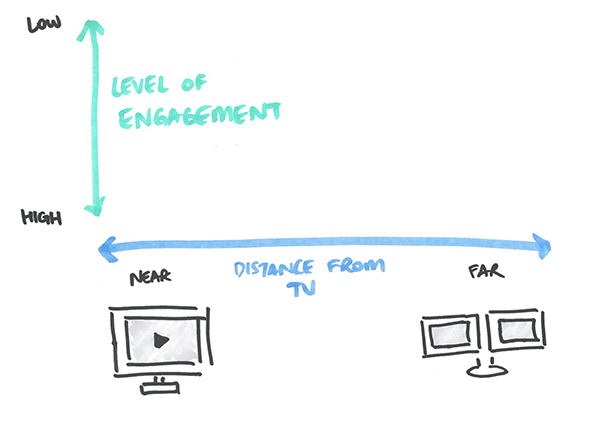
Product Development Goals
To take advantage of this actively engaged user-type, three key business goals and corresponding success metrics were outlined.
Community Building
The primary goal was to address the opportunity presented and establish a community of users actively engaging in Bloomberg content presented on-air. The primary metric to be observed would be an increase in adoption of the desktop media player due to a more compelling product. A secondary success metric though was a reduction of support tickets. Throughout the day during and after a broadcast, a number of these support tickets would arise from viewers asking for access to charts, media, applications, and other content presented on-air. With access to that media directly, support reps could better serve customers in other ways.
Data Gathering
The Bloomberg Newsroom was interested in using engagement statistics to learn what types of content most resonated with their viewers. For instance if a chart was presented about Brexit’s impact on government borrowing and we found a high-click through rate of that media in the interactive TV feed, the Newsroom could use that insight to affect future programming. The success metric for this business goal was an increase in engagement of media over time.
Education & Discovery
A key part of Bloomberg TV’s broadcasts is to present data and media on current events and in turn explain how the Bloomberg Terminal can be used to create insights. Methods of doing so include walkthroughs of Bloomberg Terminal applications and utilizing data-sets accessible on the terminal. With the interactive TV companion feed, those elements are accessible via a direct link, allowing for further exploration and learning. Ideally this in turn leads to better understanding of the Terminal as a product, further ingraining workflow into a subscribers day to day, increasing stickiness of the product. The success metric for this business goal was to measure usage data for applications that appeared on the broadcast, showing an increase in traffic for that time period.

An early sketch of what the Interactive TV feed could look like
Partnering with Bloomberg Television
Observing users is a foundational step in the process—but, when it comes to enhancing Bloomberg Television, understanding the workflow of the team that produces the live television broadcast was just as important. We had a lot of great ideas for how to enhance the Bloomberg Television experience, but after shadowing television producers during live broadcasts, we realized just how much work goes into creating a live television program.
It was equally important not just have an in depth understanding of our audience that would be using the product, but also the content creators. We learned that asking producers to assist in creating a running log of content on air was simply not feasible. Our major question became “where does the metadata produced for a television segment come from and can it be displayed?
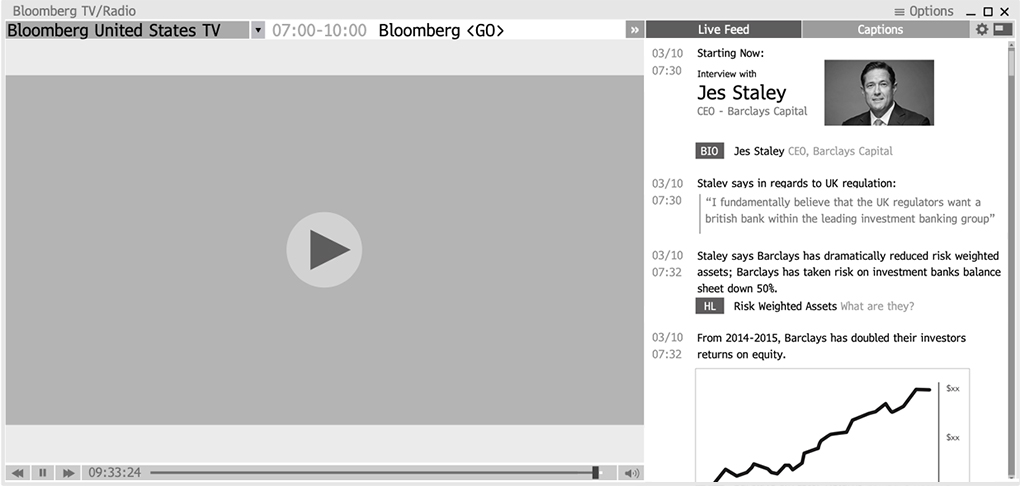
An early exploration of the media player with a representative feed based on a broadcast segment
Building the Feed
Understanding Content Generation
In an effort to understand how exactly the metadata surrounding a broadcast segment was created, we spent several sessions shadowing producers and watching as they produced the content. After follow-up debrief sessions with the producers, we learned the content displayed around a broadcast ranges from automated to human-driven. Some information, like biographies of guests was automated. Many aspects of a broadcast though were created on-the-fly through human inputs. After seeing the number of responsibilities a producer held during a broadcast, we quickly realized it would not be feasible to add to those responsibilities, meaning we’d need to automate as much of the feed as possible.
Our first step in this process was taking a thirty minute clip of a Bloomberg TV broadcast and creating a first draft of what our expectation of a companion feed would look like for that time period. Along with our product partners, we narrowed it down to our ideal feed – what we were aiming to produce. Within that feed, we created 10 categories of types of metadata ranging from news headlines to Bio link for guests on air. For each of those types of metadata, we analyzed which were currently automated and which required human intervention. For the latter we worked prioritized which metadata was a must haves, working with our Bloomberg TV partners to come up with methods of automation.
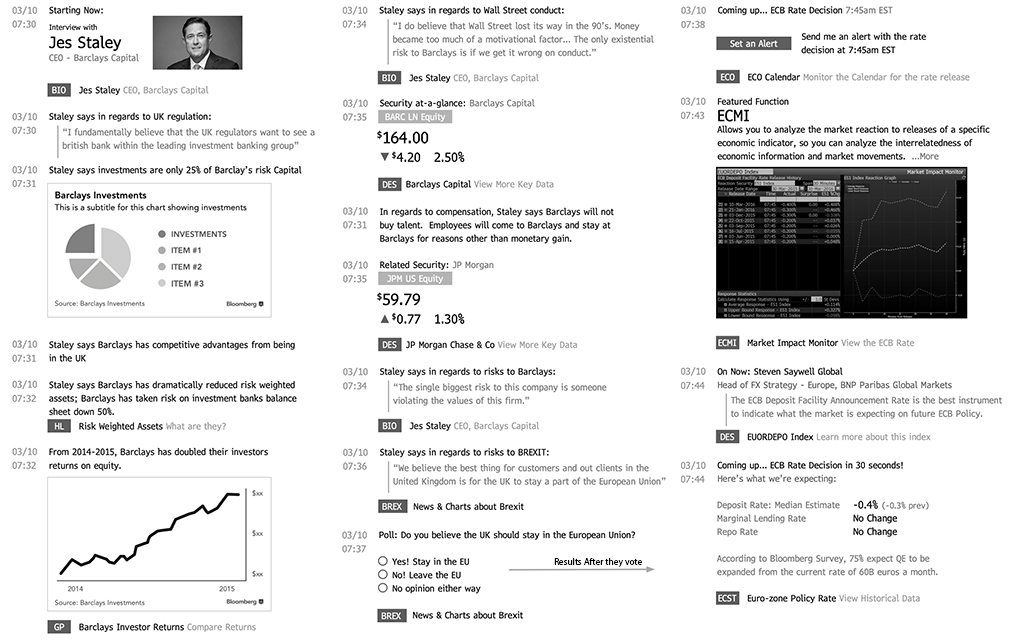
15 minutes of the mock exploratory feed
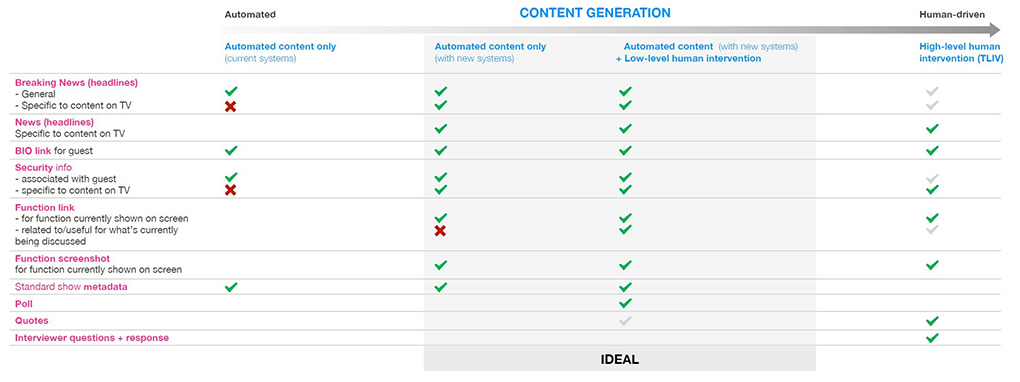
The breakdown of content types and their existing levels of automation
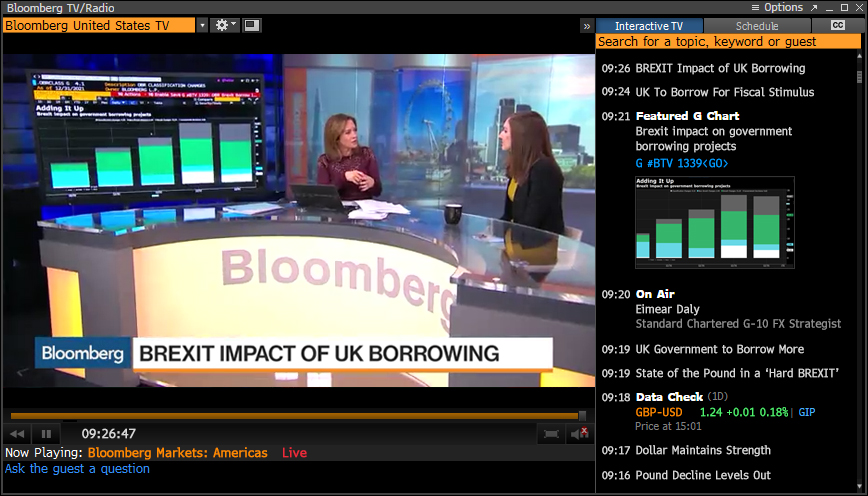
Product Release
Hitting Our Metrics
Without going into specific numbers and sharing internal usage data, through a number of different analytics we did find success in our primary goal focused on community building. The release of Interactive TV coincided with an uptick in desktop installs of the media player and a decrease in support tickets asking for content, most specifically charts shared on broadcasts.
Our second business goal centered around data gathering. We worked directly with our engineering team to make sure that the entire feed was instrumented, spending time with BloombergTV producers to show how they could access the usage data to see which segments performed best. 6 months after release, I worked closely with a Data Scientist to break down which types of metadata received the most click throughs generating a report on engagement that was presented to key executives.
Our last metric centered around education and discovery. During my 6 month retrospective with our data scientist we worked to try and prove that if an application was featured on TV it affected the traffic to that function. Unfortunately, we were not able to prove this with sufficient statistical significance. Due to the myriad number of factors that drive traffic daily, most often based on financial events like Fed Decisions or Earnings Reports, we could never isolate the Interactive TV link as the factor that drove adoption.
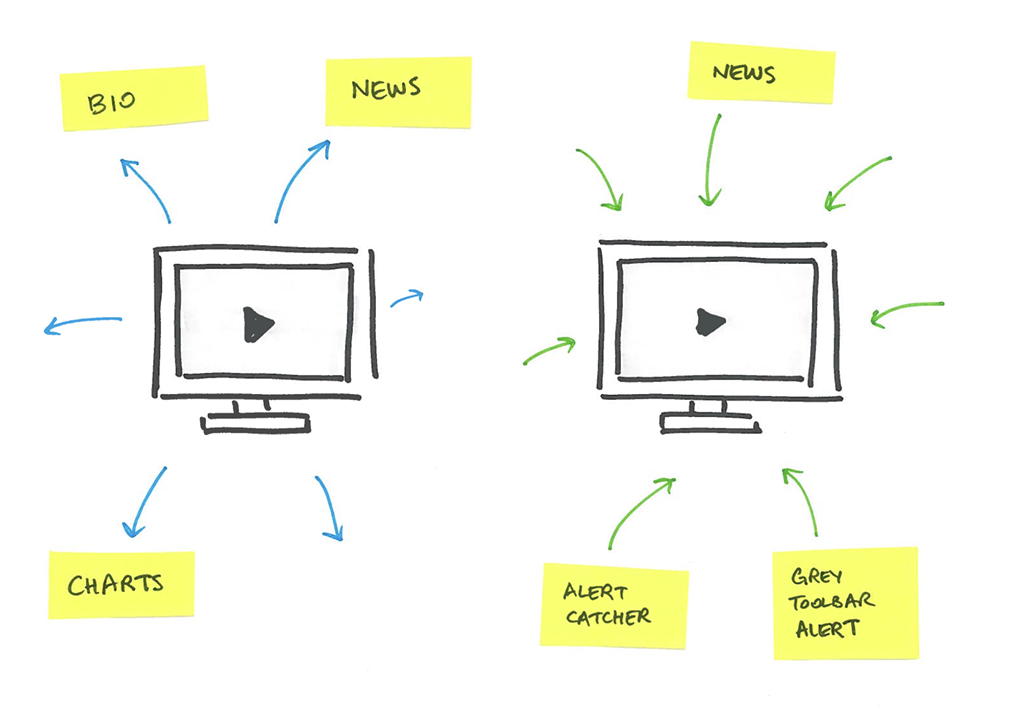
An illustration of our key business goal, the “in and the out”. We sought to both bring users into the media player, and then outward to other parts of the Terminal.
Fill out the form below and I'll get back to you ASAP.